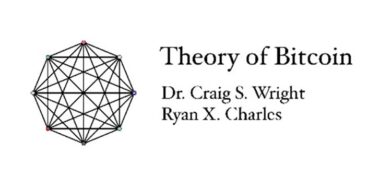This article was first published on Dr. Craig Wright’s blog, and we republished with permission from the author.
A purely peer-to-peer version of electronic cash would allow online payments to be sent directly from one party to another without going through a financial institution.
The Bitcoin white paper is a contract (Caruso, 2018). Whether you’re using Bitcoin or some poor copy of Bitcoin, such as the BTC Core network, the terms of the document are binding, and include all the nodes and all of the developers (Tiersma, 1992).
I personally always thought that I had explained it very clearly. Yet, I am autistic and have a pedantically literal perspective of many things, especially ones that I’ve put out independently and with a lot of care, such as the white paper. I find it remarkably surprising that we are still arguing about the meaning I put into the document. So today, I’m going to look at the first sentence of my paper and explain it to people. It seems to be too complex for people to understand. I’m not sure why.
The first sentence notes that payments can be “sent directly from one party to another” (C. S. Wright, 2008). Please think about the meaning of the sentence. You do not make a transaction directly by sending it through multiple hops. If you send a payment to a node, and then someone else collects from the node, the node is an intermediary. Although nodes record transactions, they are not supposed to serve as the methodology primarily used for recording transactions and processing.
Rather, as I’ve said many times, Alice wants to pay Bob. So Alice directly gives Bob a transaction, in exchange for the goods and services. Bob wants to ensure that Alice cannot ‘double-spend’ the transaction she has made. The nature of a Bitcoin transaction is similar to the nature of a negotiable instrument such as a cheque (Aigler, 1924). It forms a type of money, but is more than money when it can be settled as quickly as on the Bitcoin network. As such, it can be cash.
Once Alice has handed the transaction to Bob (think of it as Alice writing Bob a cheque and handing it to him), Alice doesn’t care any more. Alice has provided the details of her payment and met her obligation. Bob has the transaction (the cheque). For Bob to ensure that the transaction becomes valid, he needs to register ownership with the nodes. The tokens stay with Bob. The record of the transfer is now stored on-chain.
If Alice has not tried to cheat, Bob will have his transaction (received directly from Alice) recorded on the network, and his ownership can be asserted. Such is the nature of a peer-to-peer transaction. It means direct communication between parties. It does not mean having multiple entities acting as a virtual server. Rather, a peer-to-peer transaction means communication between the individuals engaging in an exchange or trade. Remember, it is electronic cash.
Bob can be notified within a fraction of a second that the transaction is valid. The nodes vote on the ordering of transactions, and accept whichever transaction they have seen first. In a fraction of a second, the nodes will return the status of the transaction to Bob. Bob will know either that Alice has given him a valid transaction, that has not been ‘double-spent’, or that she has cheated within a fraction of a second. For added certainty, Bob can check again in a few seconds. In any event, it is way quicker than what you will need to do to be able to purchase a coffee.
If Alice cheats, she will commit cheque fraud [1]. She will have done so while providing evidence of the fraud to Bob. Such evidence can be used in a court of law, and Alice can be charged with criminal fraud and theft. Digital signatures provide good evidence, that, if she cheats, will quickly be used in prosecuting Alice.
To break down the meaning of the sentence, I will give you the derivations and meaning of the words. “Purely” references something entirely or exclusively done in a pure manner. A manner without admixture. That is, a pure peer-to-peer system that is a purely transferred means to send electronic cash directly must follow it without exception. When Bitcoin was created, for example, the main way to conduct transactions was through IP-to-IP exchanges. That is, you did not send them to an address; you sent them to the person’s computer address. This computer address was their IPv4 or IPv6 network address.
“Electronic cash” references something that is not digital gold. “Electronic” is easy enough to understand, in my opinion. “Cash” references money in the form of notes or coins. While bank cheques are not cashed as you get money from an intermediary, banknotes or negotiable instruments are recognized as cash. Negotiable instruments have been used for hundreds of years. Such instruments are not paid to a particular party, but can be used again and again, and as they are used, the traditional British law makes them more valuable. I shall write about such instruments in another post.
Cash is ready money. Grant (2019) notes that “a negotiable instrument is equivalent to cash”. It is something that is quickly exchanged and settled. When someone hands you a note, and you can quickly verify that it’s real, you can quickly check whether they have deceived you. A high-quality bank cheque differs from a personal cheque. When the bearer is paid by bank cheque, it becomes a form of cash. It is a banknote, and although many countries have legally removed the ability for bank cheques to be transferred between users, there is a long history of it.
When you search for the meaning of “peer-to-peer”, you cannot simply take what people are saying today. There is a flaw in the research methodology deployed by many modern universities. Rather than allowing people to find earlier sources that give better definitions, they require students to include new publications, which are often Chinese whispers of the original idea.
When I created Bitcoin, I used the terminology that was most highly regarded at the time. Yet, in a paper by Schollmeier (2002), the concepts of different types of peer-to-peer networks were defined. The author references ‘“pure” peer-to-peer, or “hybrid” peer-to-peer or client server architecture’. The user component of a pure peer-to-peer network is one where there are no servers. A purely peer-to-peer system such as Bitcoin enables users to exchange value directly. Note that “directly” here means that you don’t go through someone else’s node. By definition, if you are sending something to any party other than the final party, it is not a direct peer-to-peer exchange.
So, when considering how Bitcoin is constructed, you need to remember that the methodology of how many people use blockchain networks is wrong and, by definition, not peer-to-peer. If you are sending information in any way other than directly, it is not purely peer-to-peer. By definition, decentralization involves pushing information to the edges. It means not creating a central node network that controls everything. It means not having a small bunch of developers setting rules and being able to arbitrarily change them. The term ‘decentralisation’ refers to individuals being able to exchange information and minority groups being able to act independently. It means that a centralized system, as seen with the BTC system or Ethereum, does not control the network (Calamari, 1961). It means that nodes cannot arbitrarily change rules.
The Bitcoin white paper does not say that the nodes are irrelevant. On the contrary, in the first sentence, it says that payments can “be sent directly […] without going through a financial institution”. When Alice gives a transaction and the related tokens to Bob, nothing goes through the nodes. The nodes do not decide whether the transaction is finalized and should be recorded. Bob does. In the exchange, Bob has received tokens from Alice in payment or exchange. They could have exchanged purchase orders and invoices offline. There could be an exchange of goods and services related to the sale. In any case, Bob has now directly received a payment from Alice.
In the exchange, the nodes operate to do nothing more than accept the reference of a time-ordered transaction from Bob and record it. There could be other information or documents that Bob has received, which he might only store the hash of. When Bob sends it to the network, he doesn’t merely send it to one node. Rather, Bob will send it to all the nodes he can see. In the BTC network, there are fifteen nodes. Of them, three control 51% of the network.
The nodes are paid a small fee to record Bob’s information. They act under an agency agreement through a unilateral contract with the issuer. In Bitcoin, I am the issuer and the responsible party in the system. I don’t shirk such responsibility. I have said so multiple times. Yet, the nodes act as honest agents and record the information, returning information concerning the validity of the transaction to Bob. Such work is what a node is paid for.
When the node registers Bob’s transaction, it adds the transaction to a block. The block is not yet valid. Only one block, from all the miners, will be validated, which is achieved through the proof-of-work process. All nodes (aka miners) can reference the order of transactions. If a miner disputes the order, there is evidence that may be used to demonstrate that one of the nodes is acting dishonestly. Such evidence can be presented in court. Dishonest nodes are effectively committing a computer crime. Such an attack is covered under various pieces of computer crime legislation around the world. Nodes present a large investment, which will be lost if they do not act honestly.
The node doesn’t care about the details of the transaction. By default, the node will assume that the owner of the transaction is the possessor, unless there is some evidence to the contrary. Evidence of ownership can always be provided through court orders, which can quickly alert the entire network of nodes and operators of any malfeasance. The concept was noted in my white paper, but I shall cover it another time.
Some people will argue that nodes act as a financial institution. Yet, for small casual payments, a node is not acting in any way where they could be seen as a trusted intermediary. Here lies an important distinction, which includes the reference to “small casual transactions” yet which I will also cover on another occasion. In any event, the recording of information and the provision of notary services differ greatly from what would present the creation of a financial institution. A financial institution cannot process more micropayments because of all the controls they need to implement around the system. For large transactions, some of them will always be required. The difference is that the freezing of assets and blocking of transactions can be automated. It can be handed over to a notary service, and the nodes can simply accept and enforce the rules applied across the network.
Nodes do not create rules. Nodes enforce rules, which is something that is documented later in my paper. But, for now, all that matters is that nodes are a notary in the sense that they are recording transactions and following a predefined set of rules. Under this form of operation, the nodes are not financial institutions. Instead, nodes provide a service for the payment of fees. The service simply involves recording transactions when they are received and rejecting any attempts at sending the same input values more than once.
The inputs in Bitcoin can be spent only once. The double-hash structure doesn’t allow collisions in the transaction ID (TXID); there will only be one TXID for any input throughout history. There is no capability to have a TXID occur more than once in the Bitcoin system. When Alice sends a transaction to Bob, she communicates directly with him. It is up to Alice and Bob to check all the legally required transactional information, and Bob can validate the information received from Alice, which includes the transactional information. Collecting information concerning know your customer (KYC) and anti-money laundering (AML) provisions does not need to fall upon the nodes (Smith & Walker, 2010).
The nodes ensure that transactions occur. It is up to Bob and Alice to ensure that they follow the rules within their jurisdiction. The system mirrors cash. If Alice hands Bob $11,000 worth of cash, Bob will be obligated to record the transaction in most jurisdictions. Because of Bitcoin, the relevant information can be privately stored, in a secure manner, which can be proven forensically, without exposing any sensitive information to the public. Here lies another aspect covered in my white paper, which will be further explained as I go through it sentence by sentence.
In summarizing the first sentence of the Bitcoin white paper, everything we’ve just covered should be clear now. Bitcoin is a direct communication system, one that allows Alice to talk directly to Bob and instantly send online electronic cash—without requiring the nodes. Instead, Bob uses the nodes to validate that Alice has not cheated him. Bob can send the transaction processing any time he wants, but the transaction is at risk until he has sent it to the nodes, so the transaction can be recorded. Once Bob sends the transaction, he will know whether the transaction is valid and that it has not been ‘double-spent’ within a fraction of a second. With such information, Bob can start providing the services Alice requested.
Nodes operate automatically. They don’t sit there with their operators choosing which transactions will or will not be accepted. Instead, all the rules are automated and run through a computer system that does not know who the individual sending transactions happens to be. The scenario does not stop the transaction from being frozen. The nodes don’t select such action, and the nodes only enforce the rules that they are given. As such, nodes cannot be promoted as a trusted third party. Such a form of internet payment intermediary was documented in my 2007 Master of Laws thesis (C. S. Wright, 2008).
I constructed Bitcoin and the nodes that index the system after completing my law degree. The reason for doing so is that I had studied and analysed English law as it would relate to internet intermediary liability. From the study, I learned that nodes would not be liable for the actions of the parties if they followed the rules, implemented required legal changes, and acted as a library in reference to publishing. By enforcing rules and not creating them, processing transactions as needed, and implementing the ability to freeze transactions, nodes can build a business that facilitates the payment of transactions, indexing transactions without allowing double-spending. It is a commercial system. It acts within the law.
The Bitcoin white paper has been available for fourteen years now. Some people had direct access at the time. Others did not. Eventually, in 2008, it was publicly disseminated. I should not have to be explaining each point at such a late stage. The terms are simple. They are not complex, and they should be easy to understand. I should not need to write nearly 3000 words documenting the meaning of the first sentence of the white paper. But, unfortunately, it seems that I have no option. In today’s Orwellian world of doublespeak (Orwell, 2021), the meaning of words has radically shifted, and people can’t seem to understand basic English.
Some people will call me angry. Some people will sense my frustration. But, there is a reason for it. I created Bitcoin as a peer-to-peer electronic cash system. I created a micropayment system that would enable the poorest people on earth to trade. Yet, it has been twisted into a criminal money laundering system and a Ponzi scheme. So when you tell me to be happy, I say, I will be happy when my system is being used as my paper dictates it should.
This article was lightly edited for clarity purposes.
***
Footnotes
References
Aigler, R. W. (1924). Recognition of New Types of Negotiable Instruments. Columbia Law Review, 24(6), 563–593. https://doi.org/10.2307/1113203
Calamari, J. D. (1961). Forging a Good Unilateral Contract or a Series of Good Contracts out of a Bad Bilateral Contract. Washington University Law Quarterly, 1961(4), 367–381.
Caruso, D. (2018). Then and Now: Mark Pettit’s Modern Unilateral Contracts in the 1980s and in the Age of Blockchains Tributes. Boston University Law Review, 98(6), 1789–1797.
Orwell, G. (2021). 1984. Antiquarius.
Schollmeier, R. (2002). A definition of peer-to-peer networking for the classification of peer-to-peer architectures and applications. Proceedings First International Conference on Peer-to-Peer Computing, 101–102. https://doi.org/10.1109/P2P.2001.990434
Smith, R. G., & Walker, J. (2010). The illegal movement of cash and bearer negotiable instruments: Typologies and regulatory responses. Trends and Issues in Crime and Criminal Justice [Electronic Resource], 402, [1]-6. https://doi.org/10.3316/informit.846224631430502
Tiersma, P. M. (1992). Reassessing Unilateral Contracts: The Role of Offer, Acceptance and Promise. U.C. Davis Law Review, 26(1), 1–86.
Wright, C. S. (2008). Bitcoin: A Peer-to-Peer Electronic Cash System. SSRN Electronic Journal. https://doi.org/10.2139/ssrn.3440802
Wright, D. C. S. (2008). The Impact of Internet Intermediary Liability [SSRN Scholarly Paper]. https://doi.org/10.2139/ssrn.2953929
Watch: The BSV Global Blockchain Convention presentation, LiteClient: Scaling Blockchain with Simplified Payment Verification
New to blockchain? Check out CoinGeek’s Blockchain for Beginners section, the ultimate resource guide to learn more about blockchain technology.









